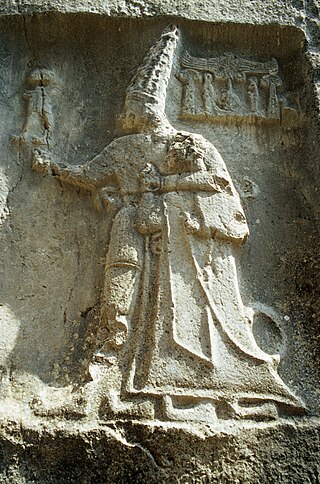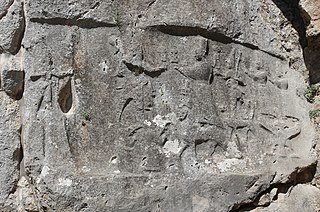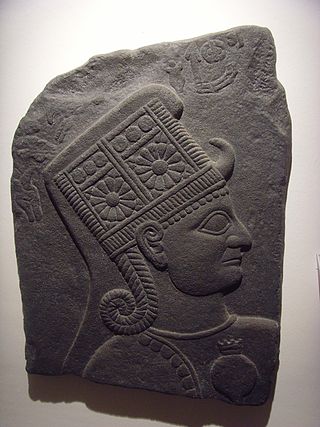
Resheph was a god associated with war and plague, originally worshiped in Ebla in the third millennium BCE. He was one of the main members of the local pantheon, and was worshiped in numerous hypostases, some of which were associated with other nearby settlements, such as Tunip. He was associated with the goddess Adamma, who was his spouse in Eblaite tradition. Eblaites considered him and the Mesopotamian god Nergal to be equivalents, most likely based on their shared role as war deities.

Šarruma, also romanized as Šarrumma or Sharruma, was a Hurrian god. He could be depicted in both anthropomorphic form, sometimes riding on the back of a leopard, and in the theriomorphic form as a bull. His character is not fully understood, though it is known that he could function as a mountain god. He was regarded as a son of Ḫepat and Teshub. He was also linked to various moon deities. Additionally, the only mythological text he appears in addresses him as a messenger (sukkalu) of Kumarbi. He was worshiped by Hurrians in southeastern Anatolia and northern Syria, for example in Kummanni and Lawazantiya in Kizzuwatna. From this kingdom he was introduced to the Hittite pantheon as well. Hittite influence in turn resulted in his introduction to cities such as Aleppo, Emar and Ugarit. He was also venerated in Luwian religion in the first millennium BCE, with theophoric names invoking him attested from as late as the Hellenistic period in Cilicia and Lycia.

Ḫebat or Hepat was a Hurrian goddess. She was the tutelary deity of Halab in origin, and in that role appears already in pre-Hurrian texts from Ebla. Her status was not identical in all Hurrian centers: while she was the main goddess in the pantheons of Halab and various cities of Kizzuwatna, her role in Ugarit and in eastern cities like Nuzi was smaller.
Kumarbi, also known as Kumurwe, Kumarwi and Kumarma, was a Hurrian god. He held a senior position in the Hurrian pantheon, and was described as the "father of gods". He was portrayed as an old, deposed king of the gods, though this most likely did not reflect factual loss of the position of the head of the pantheon in Hurrian religion, but only a mythological narrative. It is often assumed that he was an agricultural deity, though this view is not universally accepted and the evidence is limited. He was also associated with prosperity. It was believed that he resided in the underworld.

Kušuḫ, also known under the name Umbu, was the god of the moon in Hurrian pantheon. He is attested in cuneiform texts from many sites, from Hattusa in modern Turkey, through Ugarit, Alalakh, Mari and other locations in Syria, to Nuzi, located near modern Kirkuk in Iraq, but known sources do not indicate that he was associated with a single city. His name might be derived from the toponym Kuzina, possibly the Hurrian name of Harran, a city in Upper Mesopotamia, but both this etymology and identification of this sparsely attested place name remain uncertain. He was a popular, commonly worshiped god, and many theophoric names invoking him are known. In addition to serving as a divine representation of the moon, he was also associated with oaths, oracles and pregnancy. Some aspects of his character were likely influenced by his Mesopotamian counterpart Sin, while he in turn was an influence on the Ugaritic god Yarikh and Luwian Arma.

Nikkal or Nikkal-wa-Ib was a goddess worshiped in various areas of the ancient Near East west of Mesopotamia. She was derived from the Sumerian Ningal, and like her forerunner was regarded as the spouse of a moon god, whose precise identity varied between locations.

Šauška (Shaushka), also called Šauša or Šawuška, was the highest ranked goddess in the Hurrian pantheon. She was associated with love and war, as well as with incantations and by extension with healing. While she was usually referred to as a goddess and with feminine titles, such as allai, references to masculine Šauška are also known. The Hurrians associated her with Nineveh, but she was also worshiped in many other centers associated with this culture, from Anatolian cities in Kizzuwatna, through Alalakh and Ugarit in Syria, to Nuzi and Ulamme in northeastern Mesopotamia. She was also worshiped in southern Mesopotamia, where she was introduced alongside a number of other foreign deities in the Ur III period. In this area, she came to be associated with Ishtar. At a later point in time, growing Hurrian influence on Hittite culture resulted in the adoption of Šauška into the Hittite state pantheon.

Allani, also known under the Akkadian name Allatu was the Hurrian goddess of the underworld. She was also associated with the determination of fate. She was closely linked with Ishara, and they could be invoked or receive offerings together. She also developed connection with other underworld deities from neighboring cultures, such as Mesopotamian Ereshkigal, Anatolian Sun goddess of the Earth and Lelwani, and possibly Ugaritic Arsay. It is presumed she was chiefly worshiped in western areas inhabited by the Hurrians, though the location of her main cult center is uncertain. She is attested in texts from sites such as Tigunani, Tuttul and Ugarit. She was also incorporated into the Mesopotamian pantheon, and was venerated in Ur, Nippur and Sippar. Hittite sources mentioning her are known too.

The Hurrian religion was the polytheistic religion of the Hurrians, a Bronze Age people of the Near East who chiefly inhabited the north of the Fertile Crescent. While the oldest evidence goes back to the third millennium BCE, it is best attested in cuneiform sources from the second millennium BCE written not only in the Hurrian language, but also Akkadian, Hittite and Ugaritic. It was shaped by the contacts between Hurrians and various cultures they coexisted with. As a result, the Hurrian pantheon included both natively Hurrian deities and those of foreign origin, adopted from Mesopotamian, Syrian, Anatolian and Elamite beliefs. The culture of the Hurrians were not entirely homogeneous, and different local religious traditions are documented in sources from Hurrian kingdoms such as Arrapha, Kizzuwatna and Mitanni, as well as from cities with sizeable Hurrian populations, such as Ugarit and Alalakh.

Aštabi, also known as Aštabil, was a god worshiped in the third millennium BCE in Ebla, later incorporated into Hurrian beliefs in locations such as Alalakh and Ugarit and as a result also into the religion of the Hittite Empire.

Šimige was the Hurrian sun god. Known sources do not associate him with any specific location, but he is attested in documents from various settlements inhabited by the Hurrians, from Kizzuwatnean cities in modern Turkey, through Ugarit, Alalakh and Mari in Syria, to Nuzi, in antiquity a part of the kingdom of Arrapha in northeastern Iraq. His character was to a large degree based on his Mesopotamian counterpart Shamash, though they were not identical. Šimige was in turn an influence on the Hittite Sun god of Heaven and Luwian Tiwaz.

Kubaba was a goddess of uncertain origin worshiped in ancient Syria. Despite the similarity of her name to these of legendary queen Kubaba of Kish and Phrygian Cybele, she is considered a distinct figure from them both. Her character is poorly known. Multiple local traditions associating her with other deities existed, and they cannot necessarily be harmonized with each other. She is first documented in texts from Kanesh and Alalakh, thoug her main cult center was Carchemish. She was among the deities worshiped in northern Syria who were incorporated into Hurrian religion, and in Hurrian context she occurs in some of the Ugaritic texts. She was also incorporated into Hittite religion through Hurrian intermediaties. In the first millennium BCE she was worshiped by Luwians, Arameans and Lydians, and references to her can be found in a number of Greek texts.
Adamma was a goddess worshiped in Ebla in the third millennium BCE, later also documented in Hurrian sources and in Emar. The origin and meaning of her name remain a matter of debate among researchers. It is commonly assumed that it originated in one of the Semitic languages and that it can be compared to Hebrew ʾădāmâ, "soil" or "earth". An alternate view is that it belongs to a linguistic substrate at some point spoken in part of modern Syria. Hurrian origin has been proposed as well, but is considered implausible. In Ebla, Adamma received sacrificial sheep on behalf of the royal palace. She also had clergy of her own, as evidenced by references to a dam-dingir priestess in her service. Eblaite texts indicate she was also venerated in Hadani and Tunip. She was locally regarded as the spouse of Resheph, though the connection between them is not attested in later sources. After the fall of Ebla, she was incorporated into Hurrian religion, and in this context appears in Hittite and Ugaritic sources as well, often forming a pair with Kubaba. Furthermore, she was worshiped in Emar, where under the name Adammatera she might have been perceived as a deity associated with storage areas and the underworld. It is also possible that the goddess Admu known from Mari and from the Mesopotamian god list An = Anum was the same deity.

Nabarbi was a Hurrian goddess worshiped in the proximity of the river Khabur, especially in the city Taite. It has been proposed that she was associated with the Syrian goddess Belet Nagar.
Takitu, Takiti or Daqitu was a Hurrian goddess who served as the sukkal of Ḫepat. She appears alongside her mistress in a number of Hurrian myths, in which she is portrayed as her closest confidante. Her name is usually assumed to have its origin in a Semitic language, though a possible Hurrian etymology has also been proposed. She was worshiped in Hattusa, Lawazantiya and Ugarit.
Milku was a god associated with the underworld who was worshiped in the kingdoms of Ugarit and Amurru in the late Bronze Age. It is possible that he originated further south, as Ugaritic texts indicate he was worshiped in cities located in the northern part of the Transjordan region. He was also incorporated into the Hurrian pantheon under the name Milkunni. There is also evidence that he was worshiped in Hittite religion. It is possible that a closely related deity is also known from Mesopotamia.
Karhuha (Karḫuḫa), also known as Karḫuḫi, was the tutelary god of the ancient city of Carchemish. He was associated with deer, and it is presumed his character was similar to that of Hittite Kurunta. He is first attested in texts from the second half of the second millennium BCE, and there is no agreement among researchers if he was a Hurrian god in origin or if similarly to closely associated goddess Kubaba he predated Hurrian control over the region. He appears in a variety of Hittite and Luwian texts, and continued to be worshiped through the first millennium BCE.
Ilib was an Ugaritic god most likely regarded as a primordial deity. As a generic term, the word ilib seemingly also referred to spirits of ancestors. The god and the concept were most likely connected with each other. Ilib's role has been compared to that played by deities such as Alalu in Hurrian religion or ancestors of Enlil, for example Enmesharra, in Mesopotamian religion. Offerings to him are mentioned in a number of Ugaritic texts.












